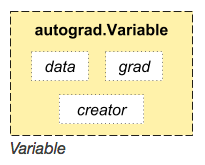PyTorch入門①:Tensors~Autograd
Tensors
Numpyのndarrays(多次元配列)のようなもの。
GPUの高速計算のために使われるオブジェクトとのこと。
以降のサンプルはチュートリアルのもの。
What is PyTorch? — PyTorch Tutorials 0.3.0.post4 documentation
作り方
1)初期化を行わず作成
from __future__ import print_function import torch x = torch.Tensor(5, 3) print(x)
2.3942e-37 0.0000e+00 -2.6457e+08
4.5848e-41 -3.8321e+08 4.5848e-41
1.0433e-37 0.0000e+00 1.0433e-37
0.0000e+00 -7.6205e+15 4.5848e-41
-7.5137e+15 4.5848e-41 -2.2547e+05
[torch.FloatTensor of size 5x3]
2)ランダム値で初期化
x = torch.rand(5, 3) print(x)
0.2182 0.7903 0.7750
0.4161 0.2828 0.3396
0.9726 0.6395 0.3299
0.3787 0.3909 0.6220
0.5164 0.6238 0.5192
[torch.FloatTensor of size 5x3]
サイズの取得
print(x.size()) # torch.Size([5, 3])
足し算
y = torch.rand(5, 3) print(x + y)
このような書き方でも良い。
result = torch.Tensor(5, 3) torch.add(x, y, out=result) # adds x to y y.add_(x)
リサイズ
reshapeではないので注意が必要。
x = torch.randn(4, 4) y = x.view(16) z = x.view(-1, 8) # the size -1 is inferred from other dimensions print(x.size()) # torch.Size([4, 4]) print(y.size()) # torch.Size([16]) print(z.size()) # torch.Size([2, 8])
Numpyとの橋渡し
1)Torch Tensor → NumPy Array
a = torch.ones(5) b = a.numpy() print(b) # [ 1. 1. 1. 1. 1.] a.add_(1) print(b) # [ 2. 2. 2. 2. 2.]
*Tensorで値を変えるとNumpyのArrayの値も変わる。
2)NumPy Array → Torch Tensor
import numpy as np a = np.ones(5) b = torch.from_numpy(a) np.add(a, 1, out=a)
*Numpyで値を変えるとのTensorの値も変わる。
Variable
Tensorをラップしたクラス。
このようなクラス構造。

x = Variable(torch.ones(2, 2), requires_grad=True) print(x)
Variable containing:
1 1
1 1
[torch.FloatTensor of size 2x2]
Autograd
自動微分機能のこと。
Autograd: automatic differentiation — PyTorch Tutorials 0.3.0.post4 documentation
Theanoよりシンプル。
import torch from torch.autograd import Variable x = Variable(torch.Tensor([2]), requires_grad = True) w = Variable(torch.Tensor([1]), requires_grad = True) y = w*x**2 y.backward() print(x.grad) print(w.grad)
Variable containing:
4
[torch.FloatTensor of size 1]Variable containing:
1
[torch.FloatTensor of size 1]